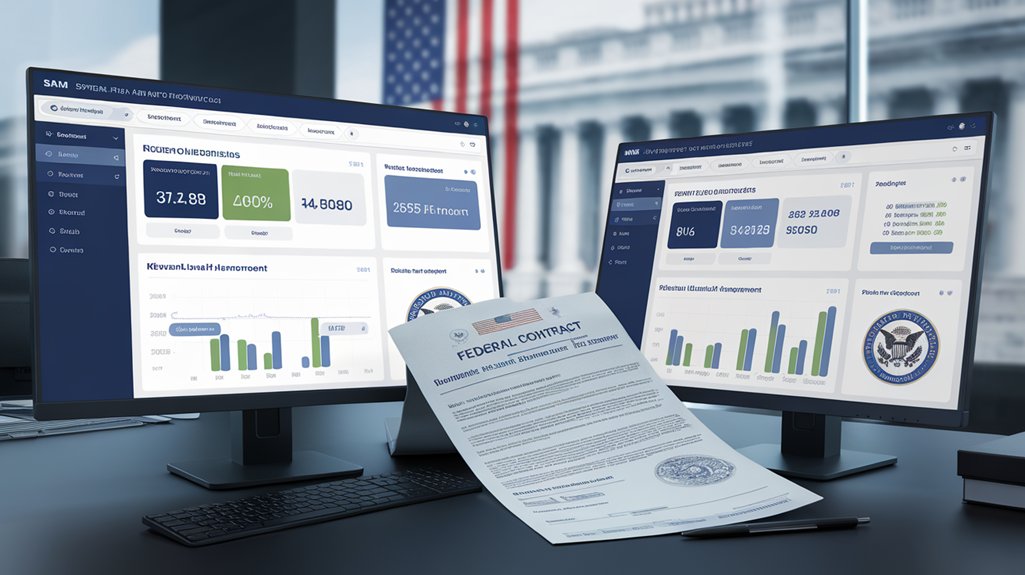Contractors can optimize SAM.gov visibility by implementing strategic keyword alignment in their profiles. This includes utilizing Boolean operators (AND/OR), embedding industry-specific terms, and incorporating relevant NAICS codes that match federal search patterns. Regular profile maintenance, competitive benchmarking through historical contract data, and geographic parameter optimization further enhance discoverability. Monitoring search metrics allows for timely adjustments based on changing agency priorities. The following strategies reveal how to transform search feedback into tangible contract opportunities.
Analyzing SAM.gov Search Metrics to Enhance Your Contractor Profile

Maneuvering the SAM.gov platform requires contractors to understand how federal buyers discover their profiles through the system’s sophisticated search architecture. Successful contractors apply search operator strategies by embedding common Boolean terms in their company descriptions, enabling their profiles to appear when buyers use the AND/OR operators to filter results. This approach increases visibility when agency procurement specialists conduct targeted searches for specific capability combinations.
Profile content optimization involves strategic incorporation of geographic parameters and entity type designations to match regional opportunities and socioeconomic preferences. Contractors should analyze which NAICS codes generate the most search traffic, then prioritize these codes in their service descriptions.
Regular review of exclusion checks and responsibility/qualification data helps identify competitive gaps that might be limiting search visibility. Additionally, integrating past performance metrics into capability statements provides credibility benchmarks that influence buyer confidence during the search process. Maintaining an active SAM registration is essential for businesses to access the vast network of government buyers and enhance their credibility in the federal marketplace.
Keyword Alignment Tactics for Maximum Federal Visibility

Crafting effective keyword strategies forms the foundation of contractor visibility in the federal marketplace. Successful contractors approach keyword optimization systematically, balancing both broad and specific terms that accurately reflect their capabilities.
Through diligent keyword research, businesses can identify trending industry terms that federal agencies frequently use in their searches. Selecting the right keywords is essential as they directly impact how search optimization functions in the SAM system. Utilizing all available character space in keyword fields is crucial, as statistics show over 50% of companies use less than half of their allowable characters.
Strategic keyword research reveals opportunity patterns by uncovering the exact terminology federal agencies use when seeking contractors.
Keyword density must be carefully managed across all SAM profile sections to maintain contract relevance without appearing manipulative. Contractors should:
- Incorporate location-specific keywords to target regional opportunities
- Include contract type terms (construction, IT services) that match their offerings
- Feature technology-related terminology aligned with their technical capabilities
- Add sustainability keywords to reflect environmental compliance
Regular audits of keyword performance help contractors adjust their strategies based on changing federal priorities. An optimized SAM profile significantly enhances company credibility when competing for lucrative federal contracts.
Competitive Benchmarking Through Historical Search Patterns

Intelligence gathering provides contractors with critical advantages when maneuvering the federal marketplace. By analyzing historical contract data from SAM.gov, contractors can develop robust competitive analysis frameworks that inform their bidding strategies.
Examining past bidder information reveals competitor approaches and pricing patterns, allowing companies to position themselves more strategically. Contractors should focus on worksite-specific rates and experience-based pricing to refine their offers. The HigherGov Price Benchmarking tool enables precise labor rate comparisons, essential for maintaining competitive edge. Analyzing the not-to-exceed rates in the tool helps contractors understand the upper pricing limits while recognizing actual rates are typically 10-20% lower.
Contract award trends indicate agency preferences, while seasonal bidding patterns help optimization submission timing. Small businesses can particularly benefit by filtering data to compare their rates against larger competitors. Proper SAM registration is essential for businesses seeking visibility and credibility when pursuing government contracts.
For maximum effectiveness, contractors should regularly monitor market conditions and analyze contract renewal rates. Engaging in networking opportunities helps build relationships with key decision-makers that influence contract awards. This systematic approach to historical data mining transforms raw information into actionable intelligence, ultimately enhancing bid competitiveness and contract capture rates.
Frequently Asked Questions
How Do SAM Search Trends Differ Between Civilian and Defense Agencies?
SAM search trends reveal distinct patterns between agency types.
Defense priorities focus on aircraft manufacturing, combat systems, and stringent cybersecurity requirements like CMMC compliance. Searches often target specialized contractors with security clearances.
Meanwhile, civilian contracts emphasize IT services, healthcare solutions, and “Cloud Smart” implementations.
Defense searches concentrate on VA/MD/DC regions, while civilian opportunities appear more geographically diverse, with notable activity in TX/CA.
Defense searches also show higher dollar values, reflecting their larger contracting budget.
Can Profile Optimization Impact Pre-Solicitation Agency Market Research?
Profile optimization greatly impacts pre-solicitation agency market research.
When contractors maintain accurate profiles with detailed capabilities and past performance, agencies gain valuable market insights during their research phase.
Government buyers rely on profile assessment to identify qualified vendors before formal solicitations begin.
Optimized SAM profiles guarantee contractors appear in relevant searches, increasing visibility to agencies conducting market research and improving chances of inclusion in pre-solicitation considerations, ultimately positioning them as viable candidates for upcoming opportunities.
What Metrics Indicate Potential Set-Aside Qualification Challenges?
Several metrics indicate potential set-aside qualification challenges for contractors.
These include historical size standard compliance violations in SAM profiles, subcontractor dependency ratios exceeding SBA thresholds, and repeated cancellations of set-aside solicitations.
Additional qualification hurdles emerge from staffing shortages affecting self-performance requirements, SAM certification lapses during contract periods, and size protest history.
Financial statement anomalies limiting bonding capacity and FPDS patterns showing declining set-aside awards in specific sectors also signal potential problems.
How Frequently Should Contractors Update Capability Statements Post-Award?
Contractors should update capability statements on multiple post-award frequency schedules.
Best practices include quarterly refreshes aligned with fiscal year cycles, immediate updates following major contract milestones, and semi-annual reassessment if no major awards occur.
Capability statement updates should incorporate new contract data within 14 days of personnel changes or certification acquisitions, and within 48 hours of receiving new NAICS/PSC codes.
Successful contractors also align revisions with GSA Schedule refreshes to guarantee compliance.
Do Agency-Specific Keywords Outperform Industry Standard Terminology?
Both agency keywords and industry terminology have distinct advantages in SAM searches.
Agency-specific keywords typically perform better when targeting particular government entities, as they match the exact language used by contracting officers.
However, industry standard terminology offers broader visibility across multiple agencies.
The ideal approach combines both: using agency-specific terms for targeted opportunities while incorporating industry standards for wider reach.
Research indicates this balanced strategy yields higher match rates and improved search visibility for contractors.